
|
|
|
|
|
The Year 2003
There were fewer airfields visited in 2003 after the good season of 2002. The visits which were made in this year were worth it. The year started with a visit to Frankfurt Rhein Main in Western Germany. This International airport is used by the United States Air Force AMC and offers very nice photo opportunities. In France Chateaudun and Cambrai were visited in the spring of 2003. The Dutch air force days were held at Twenthe and also the TLP at Florennes and the FWIT at Leeuwarden were visited resulting in good photos. In England the RIAT at RAF Fairford and Nomad at RAF Waddington were visited. The year ended in Nörvenich and Kleine-Brogel.
|
|
|
|
|
|
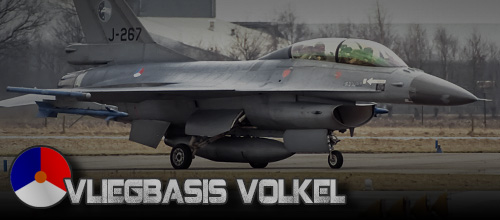
|
|
F-16 Activity at Volkel Air Base
Flying in Foggy Conditions with the MLU; Volkel, March 6, 2003
On March 6, 2003, Volkel airbase was visited. This visit was the first trip of the year and it was and there was not too much activity at Volkel. In 2000 and 2001 Volkel was the last airbase in the Nether- lands which received the MLU version of the F-16. The no 311 Squadron and no 312 Squadron were equipped with this variant in 2000. The no 306 Squadron was in December 2001 the last unit which was equipped. The no 306 Squadron lost the reconnaissance mission after the arrival of the MLU; all F-16s are able to fly these missions.
|
|
|
|
|
Transport Operations in Europe
The Military Part of Frankfurt am Main; Rhein-Main AB, March 14, 2003
The USAF airfield Rhein-Main Air Base plays an important role within the Air Mobility Command of the United States Air Force. The military part of the airport of Frankfurt is closing down at the end of the year. The tasks of Rhein-Main Air Base will be transferred to Ramstein Air Base. The U.S. airbase Rhein-Main Air Base is a part of Frankfurt International Airport. The southern side of the airportis used by the USAF and the northern side is the civilian part. The military part of the airport is used by the U.S. Air Mobility Command (AMC) of the USAF.
|
|
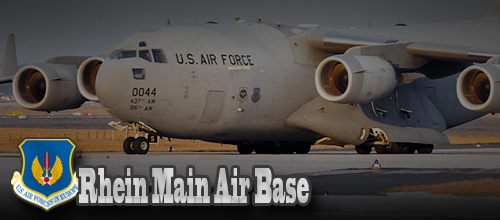
|
|
|
|
|
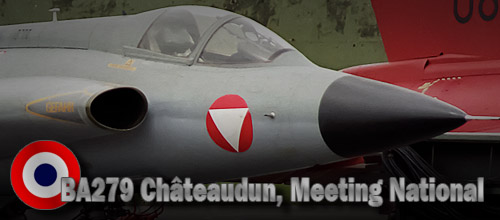
|
|
The Storage of Châteaudun
Visiting a Meeting National; Châteaudun, May 11, 2003
Châteaudun is the largest aircraft storage of the French Air Force in France. A large part of the French aircraft is in storage until they are used for a different purpose. The logistics center is supported by the Air Force Escadron de Convoyage 00.070 which is equipped with the TBM-700 for several light transport duties. The French airbase Châ- teaudun is located in the center of France about 30 kilometers north- west of the city of Orleans. Châteaudun Air Base is referred to as the French Air Force Base Arienne 279 (BA279) in the French system.
|
|
|
|
|
Escadron de Chasse 2/12
Picardie and its Mirages; Cambrai-Epinoy, June 8, 2003
Escadron de Chasse 02.012 is stationed at Cambrai-Epinoy in the north of France. This combat unit is equipped with the Dassault Mirage 2000. The main task of the squadron is the aerial defense of the north of France. The unit was already several times deployed during various conflicts in the world. The French airbase Cambrai-Epinoy is located in north of France near the town of Cambrai which is 50 kilometers south of Lille. The airbase Cambrai-Epinoy is designated as Base Arienne 103 (BA103). Cambrai is the home of the Escadron de Chasse 12.
|
|
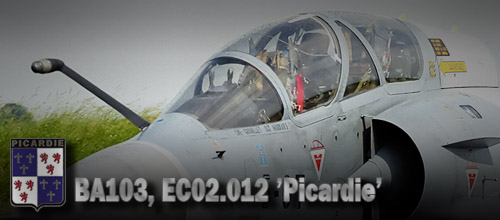
|
|
|
|
|
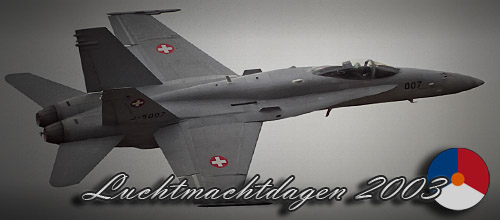
|
|
De Luchtmacht open Dagen 2003
The Last Days of Twenthe Air Base; Twenthe, June 21, 2003
This year, the annual airshow of the Royal Netherlands Air Force is probably held for the last time at Twenthe Air Base in the east of the country. This base is on the list of airfields which will be closed due to cuts in funds. Twenthe Air Base is currently the home base of the no 313 Squadron and the no 315 Squadron. In 1979, the first F-16s en- tered service in the Dutch Air Force. Twenthe became after Leeuwar- den and Volkel the third airfield which was equipped with the F-16 from 1986. The other two F-16 bases were Eindhoven and Gilze-Rijen.
|
|
|
|
|
Tactical Leadership Program 2003/3
An International Collaboration; Florennes, June 24, 2003
In the third and fourth week of the TLP traditionally additional assets will arrive for participation in the exercise. These additional participants are the opponents of the TLP participants in a modern and realistic war environment. The participants of the TLP must collaborate inten- sively to succeed the TLP mission. Without cooperation it is impossible to make the exercise a success. Participants are from nearly every country in Europe and are during this exercise trained to operate in an international partnership. This mission was the third TLP of 2003.
|
|
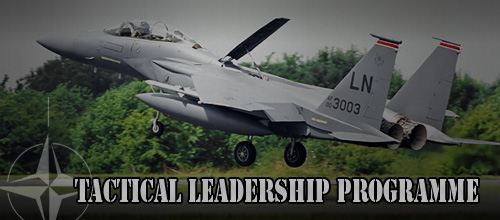
|
|
|
|
|
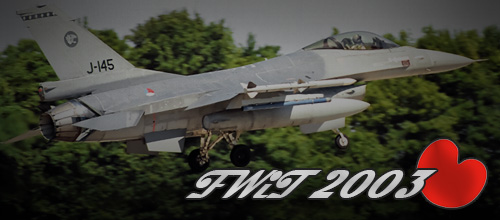
|
|
The Annual FWIT Course
F-16 Weapon Instructor Course 2003; Leeuwarden, July 15, 2003
The FWIT at Leeuwarden Air Base is an annual exercise in which weapons instructors from Belgium, Denmark, the Netherlands and Norway are trained. During the exercise at Leeuwarden, the air to air phase of FWIT training is practiced. The air to ground phase of the training takes place at Bodo Air Base in Norway. The exercise is organized annually by the no 323 Squadron which is based at Leeu- warden. All weapon aspects of the F-16 will be covered during this training. The exercise often takes place above the North Sea.
|
|
|
|
|
The Royal International Air Tattoo, part 1
The SEPECAT Jaguar; RAF Fairford, July 21, 2003
An aircraft which is often seen at the RIAT is the French/British SEPECAT Jaguar. This aircraft was originally designed as an advan- ced jet trainer. Ultimately, the jaguar has become one of the most important attack aircraft of the RAF when it comes to providing close air support and attacking hostile targets. In 1965 the two countries signed an agreement to develop the aircraft together. This interna- tional partnership became known as SEPECAT (Société Européenne de Production de l'Avion d'École de Combat et d'Appui Tactique).
|
|
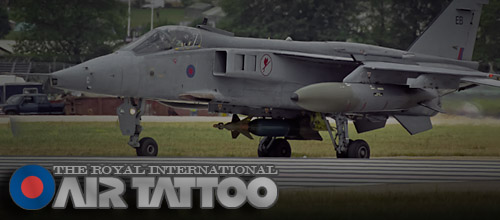
|
|
|
|
|
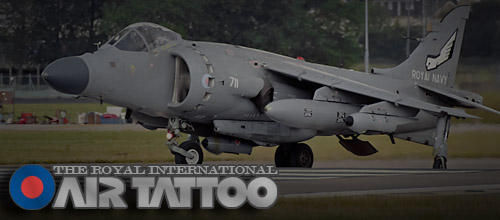
|
|
The Royal International Air Tattoo, part 2
The BAe Sea-Harrier; RAF Fairford, July 21, 2003
The British Aerospace Sea-Harrier is a STOVL (Short Take-Off & Vertical Landing) fighter aircraft of the British Royal Navy. The aircraft was originally developed by the British aircraft manufacturer Hawker Siddeley. During the RIAT there are always several-Sea Harriers present of the Royal Navy. This unique aircraft play an important role in the British navy. The aircraft operate from the three British aircraft carriers and have played a key role in several conflicts. The Royal Navy has a total of three operational squadrons with this type.
|
|
|
|
|
The Royal International Air Tattoo, part 3
The Boeing B-52 Stratofortress; RAF Fairford, July 21, 2003
One of the aircraft which can regularly be seen at the RIAT is the Boeing B-52 Stratofortress. The RIAT is usually the only place in Europe where you can photograph the B-52 on a structural base. Despite the fact this aircraft was designed in the 50s it still plays a major role in the modern United States strategic bomber fleet. In total, the USAF received more than 742 B-52 bombers in the 50s and 60s. Perhaps the B-52 will become the first aircraft in the history of aviation to reach 100 years in service of the United States Air Force.
|
|
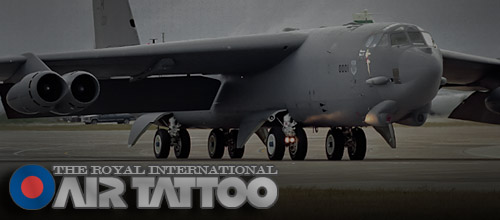
|
|
|
|
|
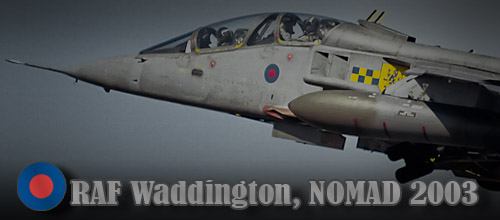
|
|
Air Defense at the ACMI Range
Nomad 2003; RAF Waddington, July 22, 2003
Every year the international exercise Nomad takes place at RAF Waddington. The exercise has a full focus on the air defense task. Participants fly an intensive program which lasts a total of two weeks. The major flights of this large-scale exercise will take place at the ACMI range in the North Sea near the British coastline. The major focus of the exercise is the air defense role. British Aerospace has developed the ACMI pod which can be mounted under planes. This pod contains a transmitter which will display the movement of aircraft.
|
|
|
|
|
The Strike Eagles of the USAFE
The USAFE 48th Fighter Wing; RAF Lakenheath, July 22, 2003
RAF Lakenheath is the only USAFE based where the F-15E Strike Eagles is stationed. The aircraft are active at the 492nd Fighter Squadron and the 494th Fighter Squadron. The Strike Eagle is one of the main attack fighters of the United States Air Force. Also the 493rd Fighter Squadron is stationed at this airbase in addition to the two Strike Eagle units. This squadron is equipped with the F-15C Eagle. During the short visit to RAF Lakenheath, there were two Strike Eagles which came back from their mission resulting in goods photos.
|
|
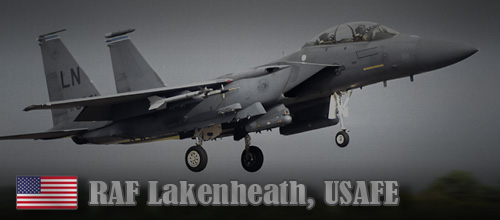
|
|
|
|
|
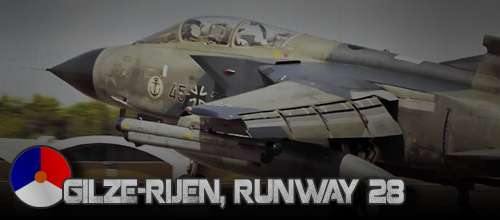
|
|
Gilze-Rijen, Runway 28
Gilze-Rijen Air Base in 2003; Gilze-Rijen, 2003
This year I was able to catch a German Tornado IDS from Marineflie- gergeschwader 2 (MFG 2) at Gilze-Rijen. This aircraft is based at the North German airbase Eggebek. This airbase will close down at the end of this year, because MFG-2 will be disbanded due to cuts in funds. The German government is will close more German airfields in the near future due to cuts in funds. The year 2003 is also the year in which the no 299 Squadron will be disbanded. This squadron flew from 1995 with the German-built Bo-105 Bölkow from Gilze-Rijen.
|
|
|
|
|
Jagdbombergeschwader 31
The Tornado’s of Boeckle; Nörvenich, October 24, 2003
Jagdbombergeschwader 31 (JBG-31) was established in 1957 at the German airbase Büchel in the former West Germany. Jagdbomberge- schwader 31 was in 1979 the first unit in Germany which switched to the Panavia Tornado. The Panavia Tornado IDS replaced the outdated Lockheed F-104G Starfighter in the unit. JBG-31 was coupled to the name Oswald Boeckle since April 20, 1962. Oswald Boeckle was during the First World War a fighter pilot who achieved great fame. JBG-31 is nowadays a modern fighter unit of the German Luftwaffe.
|
|
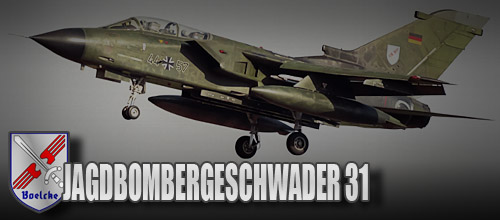
|
|
|
|
|
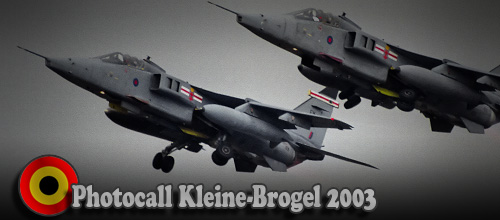
|
|
Photography under Rainy Conditions
The Photocall 2003; Kleine-Brogel, October 30, 2003
On Thursday, October 30, 2003 the now annual recurring spotter’s day at Kleine-Brogel in Belgium was on the program. During the day it is possible to stand very close to the taxi track and the runway of Kleine-Brogel. The spotter’s day is with a wide range of modern aircraft and excellent opportunity for action photography. Today's weather did not cooperate during the spotter’s day. The air base was covered under a thick layer of clouds and there were heavy showers from time to time. That’s too bad, because spotter days are always very well organized.
|
|
|
|

|







